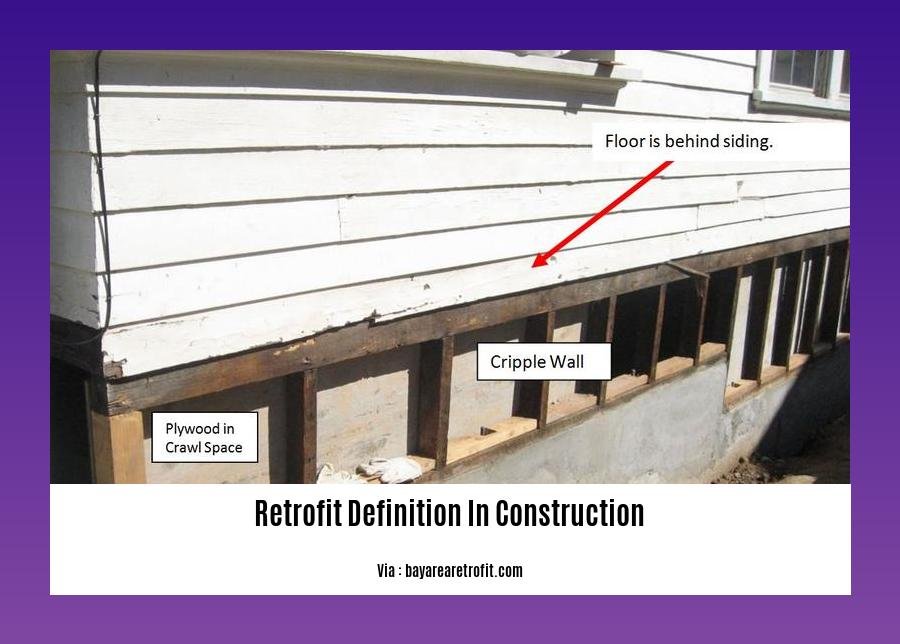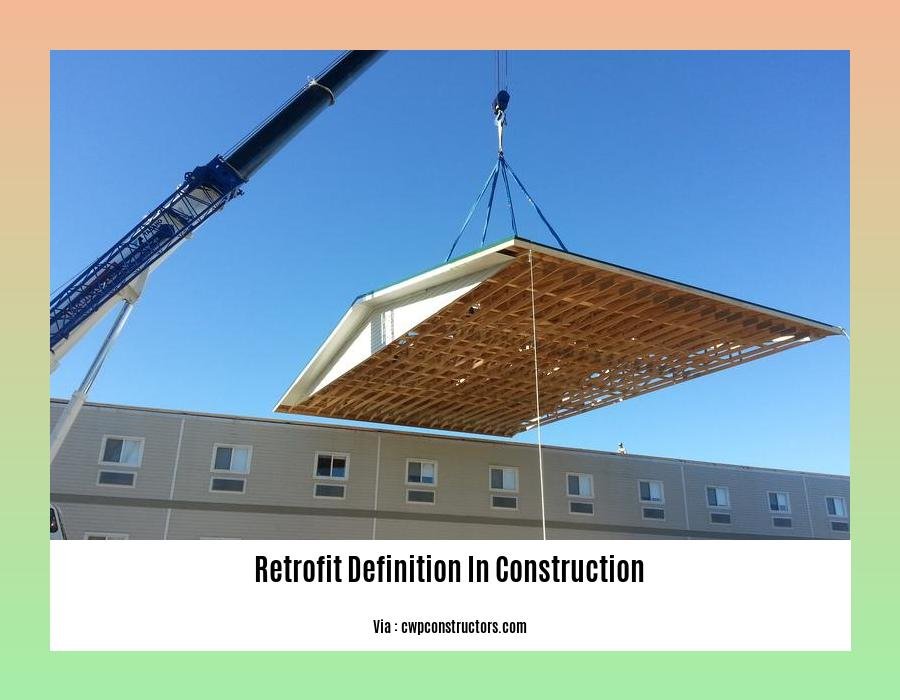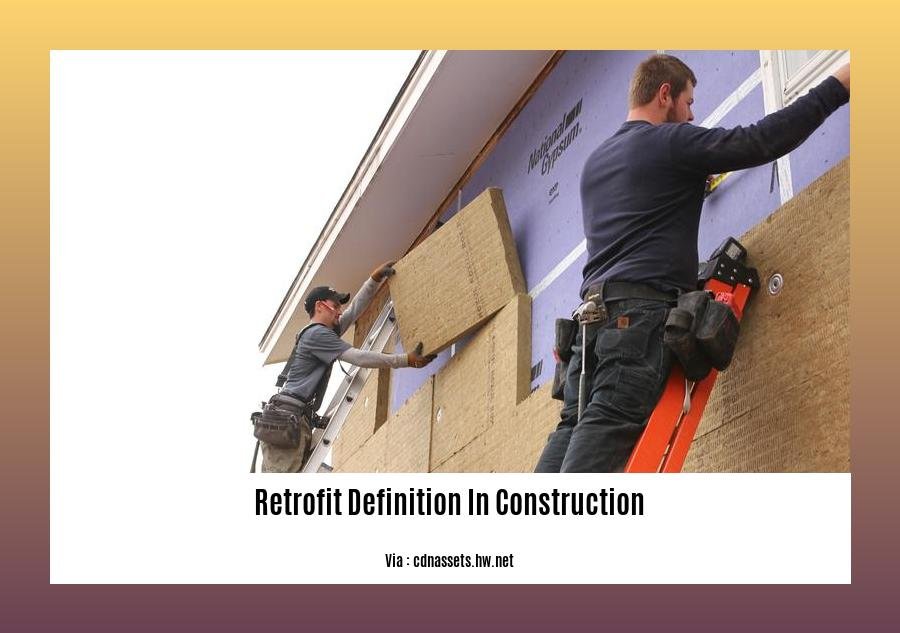When discussing the enhancement of a building’s performance and sustainability, the term “retrofit” holds great significance in the construction industry. Aimed at modernizing existing structures, retrofitting involves implementing strategic upgrades to improve functionality, safety, and energy efficiency. Through innovative techniques and expert evaluations, construction professionals can transform buildings, making them more sustainable, resilient, and aligned with evolving standards. [- Retrofit Definition in Construction: Enhancing Building Performance and Sustainability] delves into the intricacies of retrofitting, exploring its benefits, challenges, and transformative impact on the built environment.
Key Takeaways:
- Retrofitting enhances building performance, functionality, and safety by updating or modifying existing structures.
- Involves implementing new technologies, materials, and designs to improve energy efficiency and overall sustainability.
- Can include small upgrades (e.g., energy-efficient light bulbs) or major transformations (e.g., advanced heating systems).
Retrofit Definition in Construction

When it comes to the built environment, the term ‘Retrofit‘ has become synonymous with the practice of modifying or upgrading existing structures to enhance their performance, functionality, and safety. These modifications may range from minor improvements, such as installing energy-efficient light bulbs, to major upgrades involving the integration of state-of-the-art heating systems. The primary goal of retrofitting is to enhance the overall quality and functionality of buildings while extending their lifespan and reducing their environmental impact.
Reasons for Retrofitting
The decision to undertake a retrofit project can stem from various factors, including:
- Addressing aging infrastructure and improving structural integrity
- Enhancing energy efficiency and reducing operating costs
- Modernizing outdated building systems to improve occupant comfort and productivity
- Adapting buildings to changing needs and requirements
- Complying with new building codes and regulations
Benefits of Retrofitting
Retrofitting offers numerous benefits, including:
- Improved energy efficiency, leading to lower utility bills
- Enhanced occupant comfort and well-being
- Increased property value and marketability
- Reduced environmental impact through lower energy consumption and waste generation
- Extended building lifespan, reducing the need for costly replacements
Types of Retrofitting
Retrofitting projects can vary in scope and complexity, depending on the specific needs of the building. Some common types of retrofits include:
- Energy efficiency retrofits: Focus on improving the building’s insulation, lighting, and heating/cooling systems to reduce energy consumption.
- Structural retrofits: Address structural deficiencies or damage, ensuring the safety and stability of the building.
- Accessibility retrofits: Modify buildings to make them more accessible for individuals with disabilities.
- Safety retrofits: Enhance the safety of buildings by installing fire safety systems, improving emergency exits, and strengthening building structures against natural disasters.
Steps Involved in Retrofitting
A successful retrofit project typically involves the following steps:
- Assessment: Evaluating the existing building’s condition, identifying areas for improvement, and determining the scope of the project.
- Design: Developing a retrofit plan that outlines the specific modifications to be made to meet the project’s objectives.
- Implementation: Executing the retrofit plan, including the installation of new materials and systems.
- Verification: Testing and inspecting the retrofitted building to ensure it meets the desired performance standards.
-
Discover the significance of rebates in construction by exploring our comprehensive guide on rebate meaning in construction.
-
Gain insights into the processes involved in remedial works in construction and how they enhance the durability of structures.
-
Delve into the intricacies of residential roof construction and uncover the factors that contribute to a sturdy and aesthetically pleasing roof.
-
Compare the advantages and disadvantages of retrofit vs new construction windows to make an informed decision for your building project.
-
Understand the role of reveals in building construction and how they contribute to the overall aesthetics and functionality of a structure.
-
Dive deeper into the purpose and application of reveals in construction, ensuring proper installation and maintenance.
-
Explore the essential road construction equipment used in modern road construction projects and their specific roles in creating safe and efficient transportation networks.
Types of Retrofitting Techniques

Do you have an outdated building that needs a major overhaul? Retrofitting is the process of modifying existing structures to enhance their performance, functionality, and safety. It involves upgrading various components or the entire building to meet modern standards and improve its overall efficiency.
There are two main types of retrofitting techniques:
Local Retrofitting
Targets specific components of a building, such as beams, columns, or footings. It’s used to address issues in localized areas without affecting the entire structure.
Global Retrofitting
Modifies the entire structure to improve its overall performance or efficiency. This can involve adding shear walls, mass reduction, or wall thickening.
Benefits of Retrofitting:
- Enhanced structural integrity
- Improved energy efficiency
- Increased space and functionality
- Extended building lifespan
- Reduced environmental impact
Key Takeaways:
- Local retrofitting focuses on specific components, while global retrofitting addresses the entire structure.
- Retrofitting can enhance energy efficiency, structural integrity, and building functionality.
- It can extend the lifespan of existing structures and reduce their environmental impact.
Sources:
- Buildrite Construction: What Is Retrofit?
- Graana.com: A Guide to Retrofitting: Types, Benefits and More
Benefits of Retrofittings
Retrofitting is the process of modifying an existing building to improve its performance, functionality, and safety. These modifications can range from upgrading individual components to overhauling the entire structure. While the specific benefits of retrofitting will vary depending on the project, there are some general advantages that can be expected.
Environmental Benefits
One of the most significant benefits of retrofitting is that it can help reduce a building’s environmental impact. This can be achieved by improving energy efficiency, reducing water consumption, and using sustainable materials. By making these changes, retrofitting can help buildings to operate more sustainably and reduce their carbon footprint.
Economic Benefits
Retrofitting can also provide economic benefits. By improving energy efficiency, retrofitting can help to lower operating costs. Additionally, retrofitting can extend the lifespan of a building, which can save money on replacement costs in the long run.
Safety Benefits
Retrofitting can also enhance the safety of a building. By upgrading structural components, retrofitting can help to make a building more resistant to earthquakes, hurricanes, and other natural disasters. Additionally, retrofitting can help to improve fire safety by installing sprinklers, fire alarms, and other safety features.
Increased Functionality
Retrofitting can also be used to increase the functionality of a building. This can be achieved by adding new features or by reconfiguring existing spaces. For example, a retrofit can add an elevator to a building, making it more accessible for people with disabilities. It can also be used to add a new wing or floor to a building, providing additional space for tenants or occupants.
Key Takeaways
- Retrofittings offer both tangible and intangible benefits.
- Retrofitting can reduce a building’s energy consumption and carbon emissions.
- Retrofitting can enhance the safety of a building, making it more resistant to earthquakes, hurricanes, and other natural disasters.
- Retrofitting can increase the functionality of a building, making it more adaptable to changing needs.
- Retrofitting can extend the lifespan of a building, saving money on replacement costs in the long run.
Relevant URL Sources:
- Retrofitting: The Key Benefits
- The Benefits of Building Retrofits and How to Evaluate Them
Considerations for Retrofitting Projects
Every retrofit project needs a tailored approach, given the unique characteristics of each building. Here are key considerations to keep in mind:
Building Assessment:
- Evaluate the existing structure’s condition, including its integrity, safety, and energy efficiency.
- Determine the scope of the retrofit, considering the desired outcomes and budget constraints.
Design and Engineering:
- Develop a comprehensive retrofit design that addresses the identified issues and meets building codes.
- Integrate energy-efficient technologies, such as insulation, lighting, and HVAC systems, to enhance sustainability.
Materials Selection:
- Choose durable and sustainable materials that meet the specific requirements of the retrofit project.
- Consider the environmental impact of materials and their contribution to overall energy efficiency.
Implementation:
- Ensure proper coordination and sequencing of construction activities to minimize disruption to building occupants.
- Implement rigorous quality control measures throughout the retrofit process.
Post-Project Evaluation:
- Monitor the performance of the retrofitted building to assess its effectiveness in meeting the desired outcomes.
- Make necessary adjustments or upgrades as needed to optimize energy efficiency and building functionality.
Key Takeaways:
- Thorough building assessment is crucial for understanding the existing structure and its needs.
- Carefully planned design and engineering ensures a successful retrofit that meets technical and environmental standards.
- Sustainable materials and energy-efficient technologies enhance building performance and reduce environmental impact.
- Meticulous implementation minimizes disruptions and ensures the integrity of the retrofitted structure.
- Post-project evaluation allows for continuous improvement and optimization of the retrofitted building.
Relevant URL Sources:
- Retrofitting Buildings for Sustainability: A Guide for Building Owners and Facility Managers
- Retrofitting Existing Buildings for Energy Efficiency – Whole Building Design Guide
FAQ
Q1: What is the definition of retrofitting in construction?
A1: Retrofitting in construction refers to the modification or upgrade of existing buildings to improve their performance, functionality, and safety. It involves incorporating new technologies, sustainable materials, and innovative design techniques.
Q2: What are the common types of retrofitting?
A2: There are two main types of retrofitting: local and global. Local retrofitting focuses on strengthening or upgrading specific components of a building, while global retrofitting involves modifying the entire structure to enhance performance or efficiency.
Q3: What are the key benefits of retrofitting?
A3: Retrofitting provides numerous benefits, including improved structural integrity, enhanced energy efficiency, increased space and functionality, extended lifespan of existing structures, and reduced environmental impact.
Q4: What are some important considerations before undertaking a retrofitting project?
A4: Before starting a retrofitting project, it’s essential to assess the building’s current condition, determine the desired improvements, consider the energy efficiency measures, and evaluate the potential impact on the building’s historical significance or architectural character.
Q5: How does retrofitting contribute to sustainability?
A5: Retrofitting plays a significant role in sustainability by reducing carbon emissions through energy efficiency improvements, conserving resources by extending the lifespan of existing buildings, and minimizing waste by reusing and repurposing materials.
- Best Finish for Butcher Block Countertops: Choosing the Right Option - December 30, 2025
- Seal for butcher block: Find the best food-safe finish - December 29, 2025
- Finishes For Butcher Block Counters: Choosing The Right Food-Safe Option - December 28, 2025










